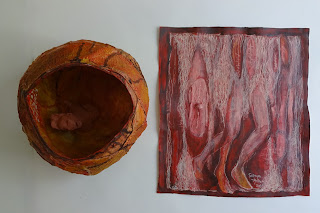Places of worship
The Roman authorities, viewing Jesus' teachings as subversive, had him arrested, tried, and ultimately punished and executed by crucifixion. As his ideas spread, the Romans believed Christians threatened the status quo, and persecuted them. Early Christian art focused on symbolic representations of the spiritual and became the foundation for future Western art. Before Rome became the center of Christianity, older communities existed in North Africa and the Near East.
The rock formations of Capadokya in the eastern Mediterranean are site of countless places of Early Christian rituals, gatherings, and learning. The painted decoration of the churches and monasteries carved in soft rocks and hidden in the magical landscape of the region, tell us about the belief of the communities that inhabited them. These carved churches also contain a profound history of art and architecture. Earliest wall paintings appear sketch-like using mainly red tonalities and incorporating simple symbols. Through time, the earlier symbols were transformed into complex frescoes full of color, figures, patterns, and narrative compositions. The architectural features of the carved churches became more elaborate: a red line, a circle or a semicircle, became carved vaults, columns, domes and arches.
These sacred places are isolated, remote and in complete harmony with the silence and beauty of the region of Capadokya. These sites survived the hardship of time, persecution, and human attacks. Many icons in the frescoes are faceless as evidence of a history of violence, iconoclasm, and different belief systems.
The Roman authorities, viewing Jesus' teachings as subversive, had him arrested, tried, and ultimately punished and executed by crucifixion. As his ideas spread, the Romans believed Christians threatened the status quo, and persecuted them. Early Christian art focused on symbolic representations of the spiritual and became the foundation for future Western art. Before Rome became the center of Christianity, older communities existed in North Africa and the Near East.
The rock formations of Capadokya in the eastern Mediterranean are site of countless places of Early Christian rituals, gatherings, and learning. The painted decoration of the churches and monasteries carved in soft rocks and hidden in the magical landscape of the region, tell us about the belief of the communities that inhabited them. These carved churches also contain a profound history of art and architecture. Earliest wall paintings appear sketch-like using mainly red tonalities and incorporating simple symbols. Through time, the earlier symbols were transformed into complex frescoes full of color, figures, patterns, and narrative compositions. The architectural features of the carved churches became more elaborate: a red line, a circle or a semicircle, became carved vaults, columns, domes and arches.
These sacred places are isolated, remote and in complete harmony with the silence and beauty of the region of Capadokya. These sites survived the hardship of time, persecution, and human attacks. Many icons in the frescoes are faceless as evidence of a history of violence, iconoclasm, and different belief systems.

Comments